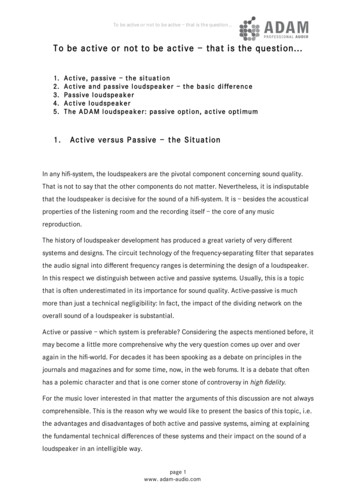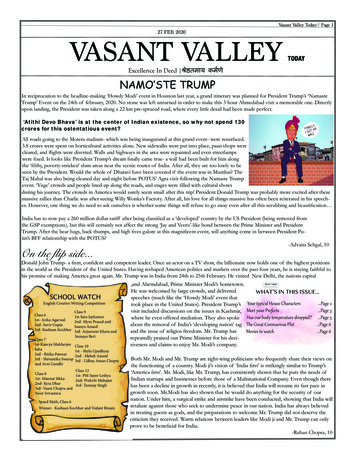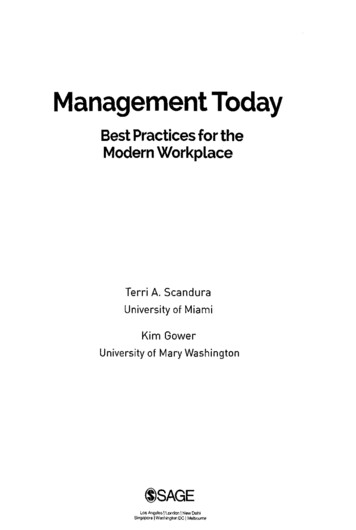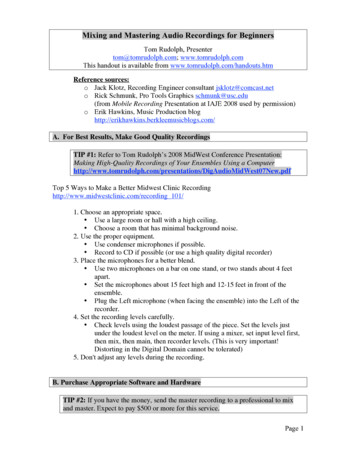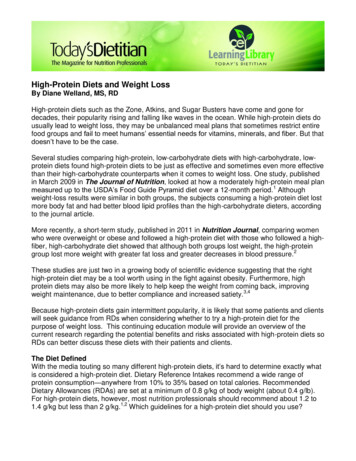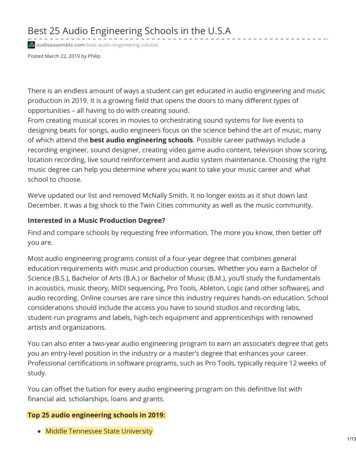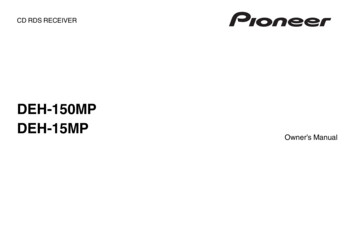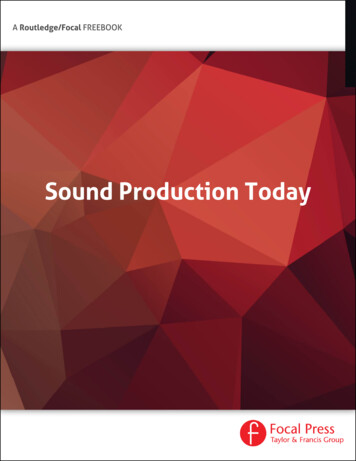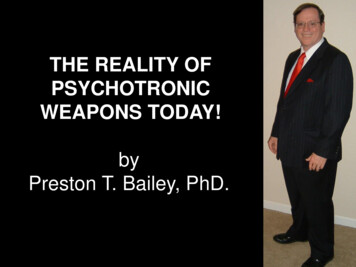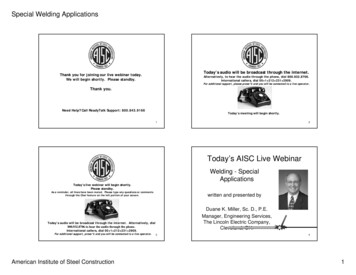
Transcription
Special Welding ApplicationsToday’Today’s audio will be broadcast through the internet.Thank you for joining our live webinar today.We will begin shortly. Please standby.Alternatively, to hear the audio through the phone, dial 800.932.8706.International callers, dial 00 1 212 231 2909.For additional support, please press *0 and you will be connected to a live operator.Thank you.Need Help? Call ReadyTalk Support: 800.843.9166Today’s meeting will begin shortly.12Today’s AISC Live WebinarWelding - SpecialApplicationsToday’Today’s live webinar will begin shortly.Please standby.As a reminder, all lines have been muted. Please type any questions or commentsthrough the Chat feature on the left portion of your screen.written and presented byDuane K. Miller, Sc. D., P.E.Manager, Engineering Services,The Lincoln Electric Company,Cleveland, OH.Today’s audio will be broadcast through the internet. Alternatively, dial800.932.8706 to hear the audio through the phone.phone.International callers, dial 00 1 212 231 2909.For additional support, press *0 and you will be connected to a live operator.American Institute of Steel Construction341
Special Welding ApplicationsChapter 12Listen to the Steel!Special WeldingApplicationsSpecial WeldingApplications5Special Welding Applications6Special Welding Applications Extending Anchor Rod Welding HSS Welding Anchor Rod to Base Plates Welding AESS Welding on Coated Steels Welding on Existing Structures Welding Heavy Sections Field Welding Welding Under High Restraint Heat Shrinking7American Institute of Steel Construction82
Special Welding ApplicationsSpecial Welding Applications Extending Anchor Rod Welding Anchor Rod to Base Plates Welding on Coated Steels Welding Heavy Sections Welding Under High Restraint9Special Welding Applications10Special Welding Applications Extending Anchor Rod Extending Anchor Rod Investigate Mechanical Options Investigate Mechanical Options Investigate “Weldability” Investigate “Weldability” Use Appropriate Detail Use Appropriate Detail11American Institute of Steel Construction123
Special Welding ApplicationsAWS Standard Terms & Definitions(A3.0-94)ASTM A6/A6M, Section X3Weldability:Weldability:“A term that usually refers to the“The capacity of a material to bewelded under the imposed fabricationrelative ease with which a metal canconditions into a specific, suitablybe welded using conventionaldesigned structure, and to performpractice.”satisfactorily in the intended service.”13Weldability Concerns With AnchorRod SpecificationsWeldability Based on compositionDriven by carbon contentCompounded by alloy contentRelated to “hardenability”“Hot cracking” concerns as well (S,Ph, others)15American Institute of Steel Construction14 High CarbonHigh AlloyUndefined Carbon, AlloyHeat Treatment (Q&T)164
Special Welding ApplicationsASTM F1554ASTM F1554Grade 36 Three Grades: 36, 55, 105– Chemistry like that of ASTM A36– Footnote: for rod diameters of up to¾ in., the manganese content is“optional with the manufacturer, butshall be compatible with weldablesteel.”– Grade 55 substituted for Grade 36(“only Grade 55 is made today”)––17ASTM F155418ASTM F1554Grade 36:Grade 55, 105:– Controls only on S and P– Grade 55 can be ordered to SupplementS1 with limits on C, Mn, Si, P, S– Also, two CE equations (“carbon” steel,“alloy” steel)– Chemistry indicates it should be readilyweldable, but .– Confusion exists (mechanical properties ormechanicals plus composition)– “Weldability only assured if Grade 55 isordered in accordance with Supplement S1”– Grade 55 supplied for Grade 36–19American Institute of Steel Construction205
Special Welding ApplicationsASTM F1554ASTM F1554– Chemistry indicates it should be readilyweldable, but .– Confusion exists (mechanical properties ormechanicals plus composition)– “Weldability only assured if Grade 55 isordered in accordance with Supplement S1”– Grade 55 supplied for Grade 36Grade 55:Grade 36:– Essentially no limits on chemistryindicate it may not be readily weldable– “Weldability only assured if ordered inaccordance with Supplement S1”Therefore, investigate on a case-by-case21basis22ASTM F1554ASTM F1554Grade 55:Grade 55:– Essentially no limits on chemistryindicate it may not be readily weldable– “Weldability only assured if ordered inaccordance with Supplement S1”– Essentially no limits on chemistryindicate it may not be readily weldable– “Weldability only assured if ordered inaccordance with Supplement S1”Therefore, investigate on a case-by-case23basisAmerican Institute of Steel Construction246
Special Welding ApplicationsASTM F1554ASTM F1554Grade 55:Grade 55 with Supplement S1:– Essentially no limits on chemistryindicate it may not be readily weldable– “Weldability only assured if ordered inaccordance with Supplement S1”Therefore, investigate on a case-by-case25basisASTM F155426ASTM F1554Grade 55 with Supplement S1:Grade 105:– Essentially no chemistry control– High strengthGood weldability should be assured.27American Institute of Steel Construction287
Special Welding ApplicationsSpecial Welding ApplicationsASTM F1554 Extending Anchor RodGrade 105:– Essentially no chemistry control– High strength Investigate Mechanical Options Investigate “Weldability” Use Appropriate DetailWeldability likely to be poor.American Institute of Steel Construction293031328
Special Welding ApplicationsNote:chisel-point,not pencil-pointAmerican Institute of Steel Construction333435369
Special Welding ApplicationsAmerican Institute of Steel Construction3738394010
Special Welding ApplicationsAmerican Institute of Steel Construction4142434411
Special Welding ApplicationsPlug weld toend of rod4546Special Welding ApplicationsPlug weld nutto end of rod Extending Anchor Rod Welding Anchor Rod to Base Plates Welding on Coated Steels Welding Heavy Sections47American Institute of Steel Construction Welding Under High Restraint4812
Special Welding ApplicationsSpecial Welding Applications Welding Anchor Rod to Base Plates Investigate Mechanical Options Investigate “Weldability” Use Appropriate DetailAmerican Institute of Steel Construction4950515213
Special Welding ApplicationsSpecial Welding ApplicationsFit of rod tobase platelikely poor Welding Anchor Rod to BasePlates Investigate Mechanical Options Investigate “Weldability” Use Appropriate DetailAmerican Institute of Steel Construction5354555614
Special Welding ApplicationsSpecial Welding ApplicationsSpecial Welding Applications Extending Anchor RodWelding on Coated Steels Welding Anchor Rod to Base PlatesGalvanized Welding on Coated SteelsPainted Welding Heavy Sections Welding Under High Restraint5758Specification for Structural Steel Buildings13th EditionANSI/AISC 360360-05M3. SHOP PAINTINGAn American National StandardSPECIFICATION5. Surfaces Adjacent to Field WeldsUnless otherwise specified in the designdocuments, surfaces within 2 in. (50 mm) ofany field weld location shall be free ofmaterials that would prevent proper weldingor produce objectionable fumes duringwelding.For StructuralSteel BuildingsMarch 9, 200559American Institute of Steel Construction6015
Special Welding ApplicationsSpecification for Structural Steel BuildingsAWS D1.1/D1.1M:2004An American National Standard13th EditionM4. ERECTIONStructuralWelding Code-Steel5. Field WeldingShop paint on surfaces adjacent to joints tobe field welded shall be wire brushed ifnecessary to assure weld quality.American Welding SocietyANSI6162AWS D1.1Common ElementsStructural Welding Code—Steel5.15 Preparation of Base MetalSurfaces to be welded, and surfacesadjacent to a weld, shall also be freefrom loose or thick scale, slag, rust,moisture, grease, and other foreignmaterial that would prevent properwelding or produce objectionablefumes. Concern about fumes Concerns about inhibiting“proper welding” “Materials” broadly defined Outcome-based requirements63American Institute of Steel Construction6416
Special Welding ApplicationsWelding Safety See ANSI Z49.1 Safety in Welding, Cuttingand Allied ProcessesChapter 15Welding Safety Available by free download from AWSwww.aws.org/technical/facts “Fact Sheets” from AWS, also available asfree downloadAmerican Institute of Steel Construction6566676817
Special Welding ApplicationsSafety and Health Fact Sheet No. 25Metal Fume Fever American Institute of Steel ConstructionOverviewEffects of OverexposurePermissible Exposure Limit (PEL)How to Avoid the HazardRespiratorsMonitoring and Measuremetnt ProceduresInformation SourcesSummary6970717218
Special Welding ApplicationsGalvanizedSteelQuality blemsoccur whenweld doesnot fuse tosteel.Porosity inweld madeongalvanizedsteel75American Institute of Steel Construction747619
Special Welding ApplicationsAWS D19.0-72 Welding Zinc-Coated SteelCenterlinecrack inweld madeongalvanizedsteelFactors affecting cracking tendencies ongalvanized steel77– The silicon content of the weld metal– The degree of penetration of the weld beyondthe root– The thickness of the base metal (which affectsrestraint)– The coating weight of the zinc (a function ofthe coating thickness)– The microstructure of the zinc coating, whichis related to the base metal composition and78the silicon content in particularSpecial Welding ApplicationsFor critical applications Qualify WPS by test Limitations of Table 4.5 may not beadequate Closely replicate field conditions Test thickest coating condition Extending Anchor Rod Welding Anchor Rod to Base Plates Welding on Coated Steels Welding Heavy Sections79American Institute of Steel Construction Welding Under High Restraint8020
Special Welding n Institute of Steel Construction8421
Special Welding ApplicationsW14x730s”ntio22”u“JmboHeavier Sections5”Larger WeldscSe 3”More Shrinkage18”85Heavier SectionsLess RollingMore TriaxialityAmerican Institute of Steel Construction86Heavier SectionsMore RestraintLess DuctiliyIncreased StressSlower Cooling87Lower Toughness8822
Special Welding Applications9089Greater Cracking TendenciesHeavier Sections91American Institute of Steel Construction9223
Special Welding 2”18”American Institute of Steel Construction24
Special Welding ApplicationsAmerican Institute of Steel Construction97989910025
Special Welding Applications101102Compression103American Institute of Steel ConstructionTension10426
Special Welding ApplicationsASTM A6, Supplementary Requirement S30Charpy V-Notch Impact Tests for StructuralShapes—Alternate Core LocationCL20 ft-lbs (27J) @ 70 oF ( 21 oC)tf /4106105ASTM A6, Supplementary Requirement S5Charpy V-Notch Impact TestJ3.6 Filler Metal Requirements20 ft-lbs (27J) @ 40 oF ( 4 oC)20 ft-lbs (27J) @ 70 oF ( 21 oC)107American Institute of Steel Construction10827
Special Welding an Institute of Steel Construction10911011111228
Special Welding ApplicationsLongitudinalshrinkage ofweb weldSTRENGTH OF METALSUNDER COMBINED STRESSESLongitudinalshrinkage offlange weldsTransverseshrinkage ofwelds113114“This is an important concept andneeds to be emphasized: no shearstress, no plastic deformation orflow.”Maxwell Gensamer1941115American Institute of Steel Construction11629
Special Welding ILE118SHEARτ1-2σ3 σ2σ1TENSILEσ2σ1TENSILEσ1 σ2119American Institute of Steel Construction12030
Special Welding ApplicationsSHEARSHEARτ1-3σ3σ1σ1 σ3TENSILEτ2-3σ3 σ2TENSILEσ2 σ3121SHEARσ2 - σ3τ2-3σ3 σ2122SHEARτ1-2, τ1-3τ1-2, τ1-3σ1TENSILEτ2-3σ3 σ2σ1TENSILEσ1 - σ2 , σ1 - σ3123American Institute of Steel Construction12431
Special Welding ApplicationsSHEARSHEARτ1-2, τ1-3Critical ShearStrength τ2-3σ3 σ2τ1-2, τ1-3TENSILEσ1Critical ShearStrength τ2-3σ3 σ2σyieldτ1-2σyield125τ1-2SHEAR126SHEARτ1-2, τ1-3Critical ShearStrength τ2-3σ3 σ2τ1-2, τ1-3TENSILEσ1Critical ShearStrength τ2-3σ3 σ2σyieldτ1-2American Institute of Steel 32
Special Welding ApplicationsSHEARSHEARτ1-2, τ1-3τ1-2, τ1-3Critical ShearStrength τ2-3σ3 σ2τ2-3TENSILEσ1σyieldτ1-3TENSILEσ3 σ2σ1σyieldDuctility129130SHEARSHEARτ1-2, τ1-3τ1-2, τ1-3τ2-3σ3 σ2τ2-3σ1σyield σtensile131American Institute of Steel Constructionσ3 σ2Fractureσ1σyield σtensile13233
Special Welding ApplicationsSHEARSHEARσ2σ1TENSILEσ1σyield σtensileTENSILEσyield σtensile133134SHEARSHEARτ1-2τ1-3, τ2-3σ2σ2σ3σ1TENSILEσyield σtensile135American Institute of Steel Constructionσ3σ1TENSILEσyield σtensile13634
Special Welding ApplicationsSHEARSHEARτ1-2τ1-2τ1-3, τ2-3τ1-3, τ2-3σ2σ2σ3σ1TENSILEσ3σ1σyield σtensileσyield σtensile137SHEARτ1-2TENSILE138SHEARτ1-3, τ2-3σ2σ3TENSILEσ1σ1,σyield σtensile139American Institute of Steel Constructionσyield σtensile14035
Special Welding ApplicationsSHEARSHEARTENSILETENSILEσ1, σ2,σ1, σ2, σ3,σyield σtensileσyield σtensile141SHEAR142SHEARτ1-2, τ1-3, τ2-3TENSILEσ1, σ2, σ3,σ1, σ2, σ3,σyield σtensile143American Institute of Steel ConstructionTENSILEσyield σtensile14436
Special Welding ApplicationsSHEARτ1-2, τ1-3, τ2-3σ1, σ2, σ3σyield σtensile145146SHEARτ1-2, τ1-3, τ2-3σ2σ3σ1, σ2, σ3,σyield147American Institute of Steel Construction14837
Special Welding ApplicationsSHEARτ1-2hminimum* 1.5 twτ1-3, τ2-3 1 in. (25 mm)(need not exceed 2 in. (50 mm)σ2hσ3σ1σyield149LW 14x7304.5”4.5”150W 14x73015”15”2.9”151American Institute of Steel ConstructionLminimum 1.5 tw15238
Special Welding Applications153Reduce WeldMetal Volumeto rackSize155American Institute of Steel Construction15639
Special Welding ApplicationsControlPlacement ofFinal WeldPassesFractureToughnessStressCrackSizeAmerican Institute of Steel Construction15715815916040
Special Welding an Instit
ASTM F1554 Three Grades: 36, 55, 105 – 18 ASTM F1554 Grade 36 –Chemistry like that of ASTM A36 –Footnote: for rod diameters of up to ¾ in., the manganese content is “optional with the manufacturer, but shall be compatible with weldable steel.” –Grade 55 substituted for Grade 36 (“only Grade 55 is made today”) – 19 ASTM .

